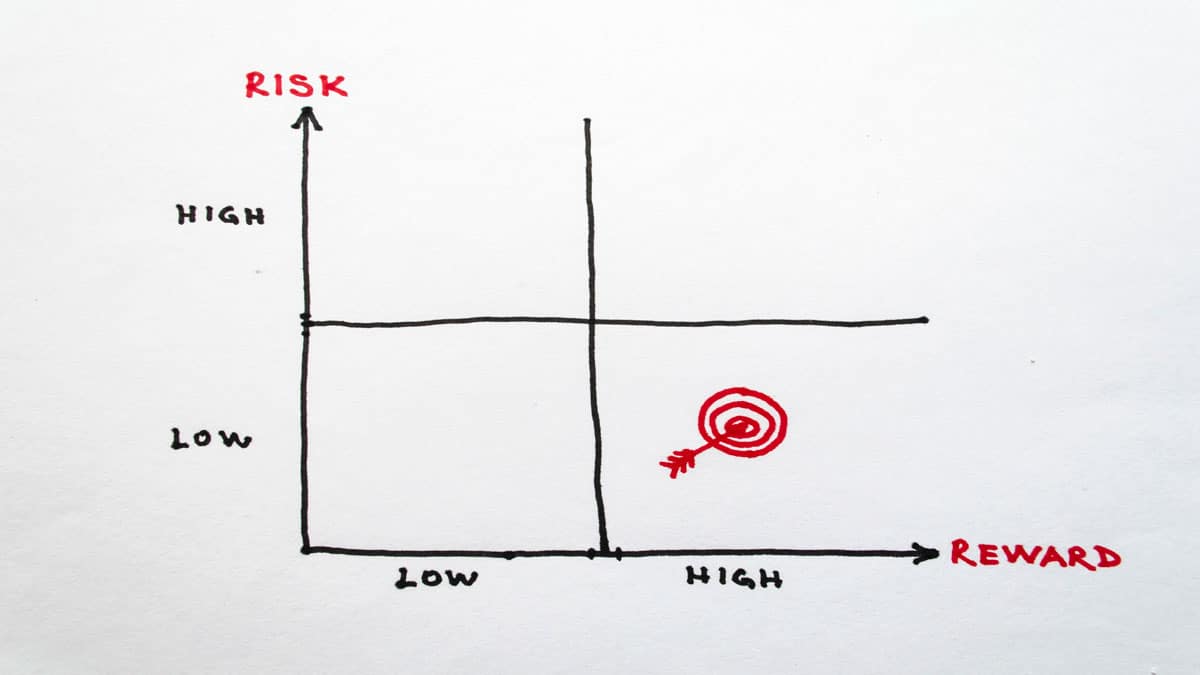THIS POST MAY CONTAIN AFFILIATE LINKS. PLEASE SEE MY DISCLOSURES. FOR MORE INFORMATION.
Are you looking to invest your money but don’t know where to start? Or have you been investing for a while but aren’t seeing your money grow?
Vanguard founder Jack Bogle, has 22 investing rules that can help you be a successful investor.
These rules are based on his years of experience in the investment world. In this article, I discuss each of the Jack Bogle investing rules and how they can help you be a smarter investor.
#1. Remember Reversion To The Mean

Don’t ever buy an investment based on what it has done in the past. Every investment you are looking to buy comes with a prospectus that tells you more about the mutual fund or exchange traded fund.
And in each one, usually on one of the first pages, it states that past fund performance is no guarantee of future returns. No matter what you are investing in, eventually the hot stock will one day not be the hot stock any longer.
Another way to look at this is the law of gravity. What goes up, must come down.
Investments are the same. High fliers will always come back down to earth. So don’t invest your money into stocks that you think will never come down because eventually they will.
#2. Time Is Your Friend, Impulse Is Your Enemy

Compound interest is your greatest asset when it comes to investing. This is because the longer your money stays invested, the more it grows into.
For example, let’s say you invest $25,000 at age 25 and you earn 8% annually on that money. Here is your balance in 10 year increments.
- Age 35: $53,973
- Age 45: $116,523
- Age 55: $251,566
- Age 65: $543,114
- Age 75: $1,172,540
If you stop investing after 10 years, you miss out on over $1 million dollars! So why do so many people give up investing?
Impulse is your enemy. When the market drops, they get scared and make the investment decision to take their money out.
They don’t want to lose any more money, so they decide to protect what they have left and wait. The problem is many investors wait too long to invest again. In some cases, they never come back.
These bad investment decisions end up costing them thousands of dollars.
#3. Buy Right And Hold Tight

This lesson is simply saying that once you do the initial work of determining your asset allocation and diversifying your investments, you need to stick to it.
And you hold tight no matter what the market is doing.
That might sound easy, but when the market is rising and everyone around you is saying how they are making money hand over fist with their stock holdings it can be hard.
And it can be even harder when the market is crashing down and everyone around is predicting doom and gloom.
This is why the average investor never earns what the market does.
They jump in and out of the market or between investments too much, which lowers their overall investment returns.
The most successful investors who stick with the same holdings for decades, and focus more on time in the market vs. market timing.
#4. Have Realistic Expectations

The worst thing you can do is have the wrong expectations when it comes to investing your money. John Bogle uses a great analogy to help you understand this investing rule, the bagel and the donut.
The bagel is healthy and nutritious for you, or long term investing. The donut is sweet but not healthy for you, or short term investing.
While we all love a donut, to be a successful investor, you need to focus on the bagel.
The returns of short term trading can be great, but for most investors, it is not sustainable in the long run.
So while you might beat the market or earn high returns now, in a few years, chances are you won’t be achieving the same level of success. It goes back to the first rule, reversion to the mean.
#5. Forget The Needle, Buy The Haystack

Most investors look for the needle or that one stock that will be a home run. You see this all the time if you read a lot about investing.
You’ll hear things like, “if you invested in Amazon back in the ’90s” or “if you put $100 into Apple stock in the late ’80s”, you’d be a multi-millionaire.
While it is true you would have made out well financially investing at the perfect time in those stocks, look at the odds of picking those stocks.
There are thousands of publicly traded stocks out there. Your chances of picking the one that will give you a home run is like finding a needle in the haystack.
The better use of your time and money is to simply own the haystack, or invest in the entire market through low cost index funds.
This way, you guarantee you own Apple or Amazon. And while you won’t own as much if you invested in that stock alone, you will come out ahead since most investors won’t get lucky enough to invest in those stocks at the right time.
Related: Here are the pros and cons of index funds
#6. Minimize The Croupier’s Take

To understand this rule, you first need to know what a croupier is. A croupier is the person in charge of the gambling table.
In other words, the person that ends ups making all the money. When it comes to investing, you have to be aware of fees.
When you invest in mutual funds and exchange traded funds, there is a management fee you pay. You are never billed for this fee, it comes out of the return of the fund itself.
For example, if you are charged a 1% expense ratio and the fund has a gross return of 9%, you only earn 8%. The other 1% is the fee you pay.
This doesn’t sound like a big deal. But go back to rule #2 about compounding interest. It also works for the fees you pay as well.
If you invest $25,000 in a mutual fund that charges 1% annually, and you stay invested for 40 years, earning 8% annually, you end up with $363,327.
Not bad. But you paid $52,800 in fees. While this is a lot of money, many might accept this because of the great return you made.
But let’s say you invested that same $25,000 for 40 years, earning 8% annually in a fund that charged just 0.15%.
You would end up with $511,461. That is close to $150,000 difference!
But if you look closer the difference in fees is only $43,000.
What happened to the other $100,000? That is the effect of compounding interest on your fees.
Had you invested in a fund with lower fees, more of your money could have stayed invested and grown into larger sums of money.
So while paying just 1% doesn’t sound like a big deal, in the years to come as your balances grow in size, these high fees become a huge deal.
#7. There’s No Escaping Risk

No matter where you put your money, either in the stock market, in the bank, or even under your mattress, there is risk involved.
Too many investors who are too scared of the market decide to play it safe and invest their money in a savings account or certificate of deposit.
They see that they can’t lose money in these investments, only earn interest. But the truth is, these investments are risky.
They are risky because they earn so little interest that they don’t keep up with inflation. So in 10 years, while they still see the balance of their savings account the same or a little higher thanks to interest, the reality is they lost 30% of their purchasing power due to the effect of inflation.
As prices rise over time, your money becomes less valuable. And if you don’t earn at least the inflation rate, which averages between 2-3% annually, you are losing money.
#8. Don’t Fight The Last War

Many times we do things based on what happened in the past.
It’s human nature. If you open your heart to love someone and they break it, you will put up a wall and make your next relationship harder to avoid the possible pain.
The same holds true with investing. We look at what happened in the past and invest based on that instead of looking at what is happening now.
For example, technology stocks might have been the best investments for years but now are beaten down.
Using past performance as a guide, these investors think this sector has to outperform again.
So they will invest in these stocks even though there are other sectors of the market that are in favor right now. The bottom line is, don’t focus on the past, look at what is happening now.
#9. The Hedgehog Beats The Fox

This is a great analogy about passive investing and active management.
The hedgehog is the idea of index investing, where you just buy the market and sit back and let it do its work. The fox is the more fun one, the idea of investing in actively managed funds.
The problem is most times, active management doesn’t outperform passive management, it underperforms.
There are years where active managed funds do beat the market, but they never do it consistently, year after year.
#10. Stay The Course

You need to stay the course, or invest for the long term.
Once you assess your financial situation, your financial goals, have your asset allocation determined and are fully diversified, you need to stick with your investments long term.
You can’t jump in and out of the market. You can’t switch between investments every few years.
Whatever you buy, you hold until retirement and add to these positions over time. When you do this, you earn what the market earns and as a result, end up with a healthy sized nest egg.
Related: See the power of buy and hold investing
#11. Forget The Market

The lesson here is to ignore the daily movements of the stock market if you want to experience successful investing.
You are investing for the long term, so the day to day movements do nothing for your benefit. However, they do increase the likelihood you react negatively, get greedy or fearful and don’t see your plan through.
#12. Understand Your Role

Your role is to achieve the return of the market as a whole.
If you can do this, you will be well off financially, assuming you start investing as soon as possible. Don’t try to chase returns or pick individual stocks.
The odds are stacked against you. Invest in low-cost index funds and invest as soon as you can.
#13. Don’t Kid Yourself

Many people think that by investing in actively managed funds, they will outperform the market because the management team is going to outsmart the market.
But when you stop and think about it, no management team has ever been able to beat the market over time.
Sure they do it for a year here and there, but no one has been able to do it year in, year out.
In other words, when you invest in actively managed funds, you are hoping or wishing you beat the market. And when you don’t beat the market, you earn less than the market.
As a general rule of thumb, you are better off just picking a passive index fund.
#14. Seek Boredom

Investing should be boring, not exciting. When it is exciting, you are allowing your emotions to make the decisions for you.
When you invest in index funds and hold them for years, investing is boring. You keep your emotions out of investing and let the market and compounding work its magic.
And when it is time to retire, you have a large nest egg to enjoy.
#15. Think Ahead. Way Ahead.

You need to have a long time horizon to invest in the stock market.
If you need the money in a few years, you are better served putting into a savings account. But for retirement investing or anything more than 10 years, financial markets are what is going to give you the best return on your money.
Related: Here are the best long term investments to invest in
#16. Forget “The Number”

Don’t focus on a number of dollars you need for retirement. If you invest thinking you have to have $2 million for retirement, it is going to get you emotionally involved.
And as has been pointed out numerous times, that is not good. Instead, focus on saving as much as you can and investing it in low cost, passive index funds.
By the time retirement comes, you will have more than enough money to enjoy your golden years.
Related: Here is a guide to help you know how much you need for retirement
#17. Invest, Don’t Trade

Trading stocks or jumping in and out of investments all the time is a fool’s game.
You are bound to lose money. This is because you never know when is the right time to invest. Plus you are at the whim of the market.
Maybe you invest in a stock thinking it is going to soar, then a market correction happens and it loses 20%.
What do you do now? Do you sell and realize a 20% loss of money or do you hold and wait for it to recover in a few years?
Don’t risk it. Invest in mutual funds or ETFs for the long term and remove this risk.
#18. Do Some Math

Whenever you invest, you have to calculate the cost of fees. If you think you can earn 8% on your money by investing, you have to subtract the cost or management fees from this number.
So if the fund charges 1%, now you are only earning 7%. What impact does this have on your money?
Take the time to understand the impact of higher costs versus lower costs and you will be a smarter investor.
#19. Keep It Simple

Don’t over complicate the makeup of your portfolio. You don’t need 20 mutual funds to be diversified.
In fact, many successful investors have just 3 funds.
Simply take your age and put that amount of money into a bond fund and the rest into equities. It sounds too simple, but it works.
#20. Don’t Peek At Your Statements

Opening up your statements every month or every quarter is a common mistake many investors make. You will see that you lost money and might want to sell out.
Or you might see you are ahead of the game and stop saving more. Basically, you allow your emotions to matter again.
Ignore your statements and keep investing.
Related: Learn how long to keep financial statements
#21. Know Your Limitations

You’ve probably heard the saying “buy low, sell high” when it comes to investing. But do you know when high is?
With a market that moves higher over time, it is hard to predict. It is just as hard to know when the bottom of a selloff happens too.
Save your energy for other things and don’t try to live by this mantra. Instead, use a dollar cost averaging investment strategy to consistently invest over time.
#22. Don’t Panic, Be Cool

While the market over time goes up, there are bumps along the way. Corrections, crashes and pullbacks happen all the time.
These events can cause your portfolio to lose 30% or more in a short time.
But you have to remember these events are temporary. It’s like driving down a road with potholes.
You’ll hit one now and then, but eventually, you will get past them and be on a smooth road again.
Stick to your plan and know that market drops happen but in the long run, you will come out ahead.
More From Money Smart Guides

Do you want to know how to invest and build wealth? Here is a step-by-step guide to help you do just that. HOW TO BECOME A STOCK MARKET MILLIONAIRE
Is VTSAX A Good Investment?

Many people consider investing in the Vanguard fund VTSAX. But is it s good investment or right for you? Here is what you need to know. IS VTSAX A GOOD INVESTMENT?
Dave Ramsey’s Investment Advice Is Trouble

Dave Ramsey is the king when it comes to getting out of debt and building a financial foundation. But his investment advice could leave you with no money to live on. Learn why you need to heed caution when it comes to his investing advice. WHY YOU NEED TO IGNORE DAVE RAMSEY’S INVESTMENT ADVICE
How To Start Over Financially At 50

It can be difficult to start over financially at any age. But when you are 50, there is added pressure. Not only do you have a limited number of working years left, but you also see how well others in your peer group are doing. If you are starting over at 50, don’t give up hope. Here is how to drastically improve your finances. HOW TO START OVER FINANCIALLY AT 50
How To Invest In Yourself

We all know we grow wealth by investing in the stock market or putting our money into savings accounts.
But many of us are unaware that the best returns are by investing in ourselves. When we improve ourselves, we have the ability to earn a lot more money, which makes it easier to become filthy rich.
LEARN HOW TO INVEST IN YOURSELF
I have over 15 years experience in the financial services industry and 20 years investing in the stock market. I have both my undergrad and graduate degrees in Finance, and am FINRA Series 65 licensed and have a Certificate in Financial Planning.
Visit my About Me page to learn more about me and why I am your trusted personal finance expert.

